Wabi-sabi is a Japanese aesthetic philosophy that finds beauty in imperfection and transience.
Rather than valuing pristine, perfect designs, wabi-sabi embraces natural materials, asymmetry, irregular shapes and the patina of age.
This organic, rustic style is the perfect antidote to sterile, cookie-cutter bathroom designs.
By bringing wabi-sabi elements into your bathroom, you can create a space that feels warm, tranquil and connected to nature.
In this article, we’ll explore 13 wabi-sabi bathroom ideas to help you cultivate this relaxed, peaceful style in your own home.
These ideas will show you how small details can make a big impact in creating a bathroom that nourishes your soul.
Read on for inspiration to design a beautifully imperfect, wabi-sabi style bath.
✨Click to Get My 101 FREE Designer Room Ideas
Idea 1: Stone Bathtub
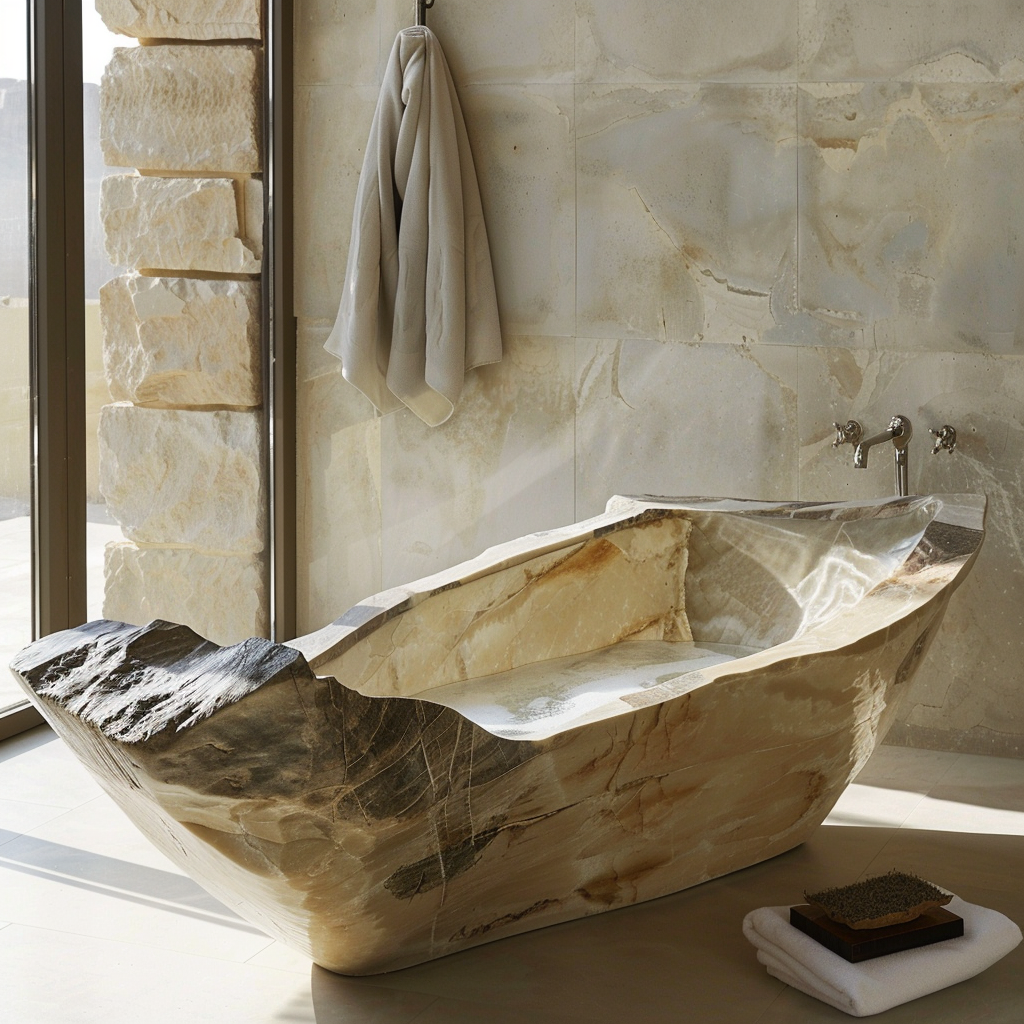
Natural stone makes a wonderful focal point in a wabi-sabi style bathroom.
Materials like granite, marble or limestone bring texture and imperfect beauty to the space.
Consider installing a stone bathtub as an elegant centerpiece.
An oval or irregularly shaped tub looks especially lovely.
Allow the veining and natural variations in the stone to show through rather than polishing it to a high gloss.
You can install your tub as a freestanding model or build it into the floor and wall.
Surround it with wood or stone to complement the overall design.
A stone bath has a timeless, spa-like feel and the hardness of the material makes it extremely durable.
The mineral content of stone makes is naturally antibacterial as well.
Sitting in a heated stone tub can be very therapeutic for both body and mind!
The solidity and coolness of the stone material creates a very grounding yet luxe bathing experience.
Choose a tub carved out of granite, marble, limestone or other natural stone that appeals to you.
Neutral colored stones like white, gray, black or brown work especially well in wabi-sabi style bathrooms.
Allow the natural variations and imperfections in the stone to show through for an organic look.
Installing a stone bathtub makes a bold statement in your bathroom.
The solid stone material and natural hues align perfectly with wabi-sabi ideals.
Soaking in a mineral-rich stone tub allows you to connect with nature and provides a soothing, Zen bathing experience.
This unique focal point anchors the space with its raw, organic beauty.
Idea 2: Wood Vanity
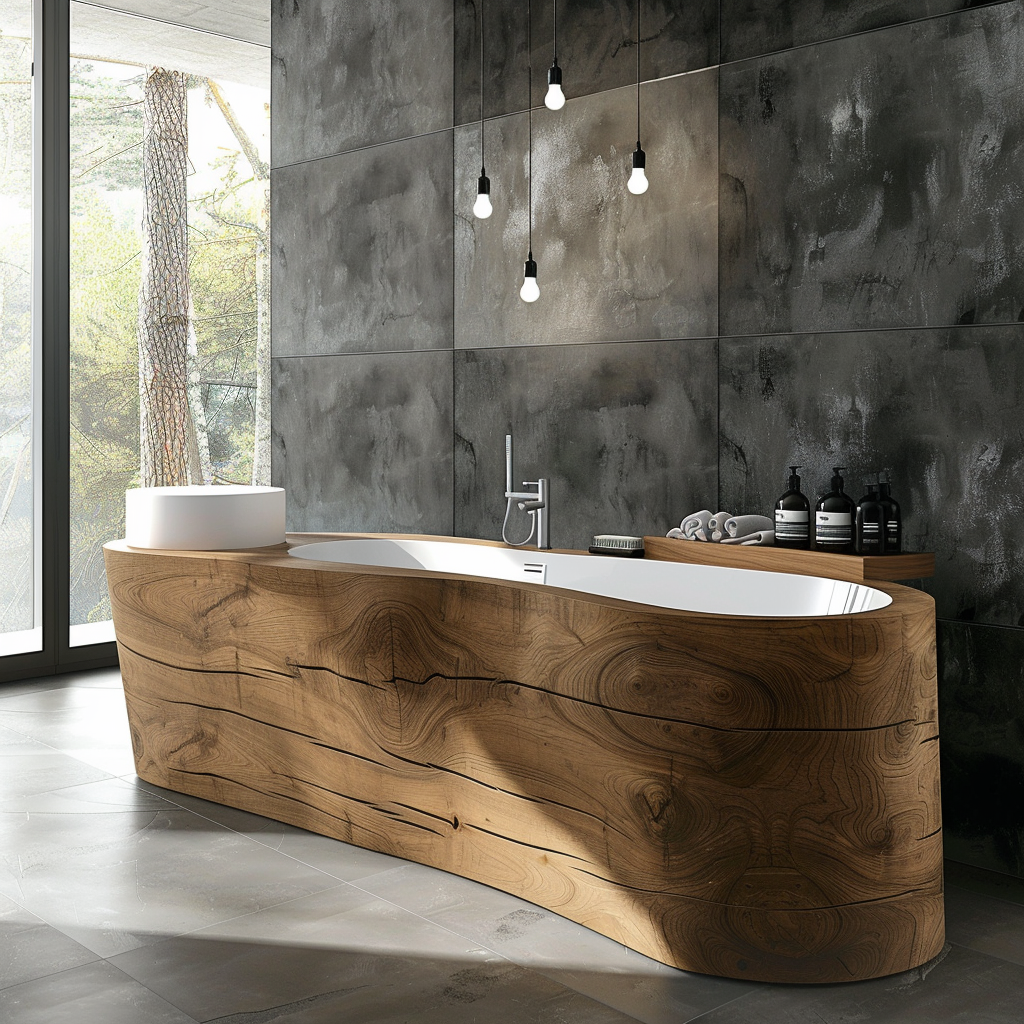
Wood makes a warm, organic choice for bathroom vanities in a wabi-sabi style space.
Choose a reclaimed wood vanity for lots of character and imperfections that celebrate natural beauty.
Distressed, washed or smoked wood finishes also fit beautifully with the wabi-sabi aesthetic.
Consider combining wood shelves or cabinets with a stone countertop on top to marry natural materials.
Or opt for an old-fashioned washstand style vanity with legs and a towel bar underneath.
Wood pairs nicely with round or oval sinks for a soft look.
Aim for a style that looks like it was handed down through generations, with dents, engraved markings or a faded patina.
Seek out authentic antique vanities, or new pieces that are intentionally distressed.
Unfinished, raw wood with knots and grain provides texture and depth.
An unassuming vanity in aged wood makes a lovely addition to a wabi-sabi bath.
The natural material brings warmth and harmony with nature into the space.
Weathered, imperfect wood has a rustic, cozy feel that calms the senses.
Guests will delight at its well-loved charm.
Idea 3: Natural Stone Tiles
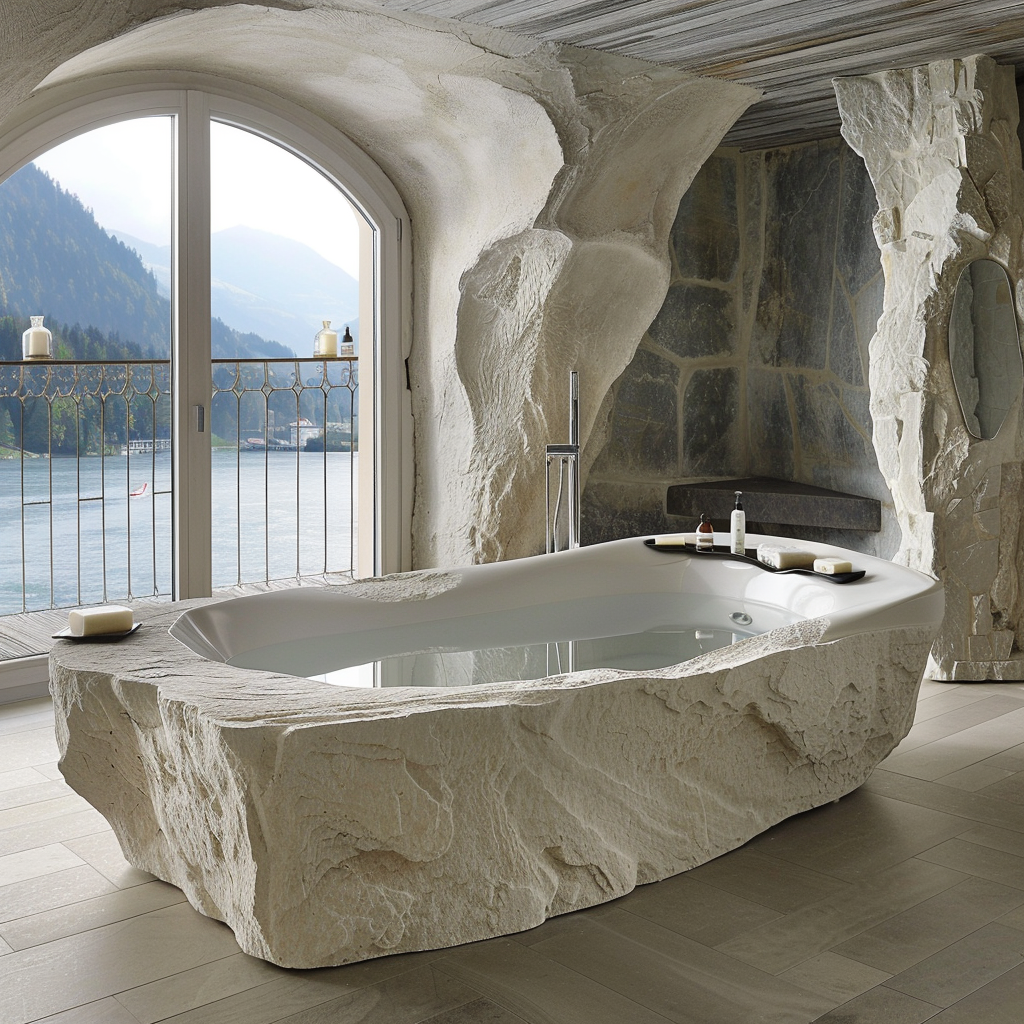
Stone tiles lend organic texture and imperfect beauty to wabi-sabi style bathrooms.
Natural stone options like slate, travertine, limestone, river rock and pebbles make lovely flooring or wall surfaces.
Old stone pavers also make a wonderful repurposed tile option.
Achieve harmony with nature by using stone in neutral, earthy hues.
Mix tile sizes and shapes for an asymmetric, imperfect look.
Varying shades and veining in the tile prevent a uniform appearance for a lovely, flawed effect.
Irregular hand cut stone tiles or tumbled rocks embrace natural diversity.
Leave grout lines wide for a historic, aged finish.
Stones that are weathered or exhibit signs of their former lives as roof tiles or flooring make unique additions.
The imperfections in the stone reflect wabi-sabi ideals.
Natural stone lends subtle variations, changing patterns and rich textures inspired by the beauty of the earth.
Tiles with roughness, cracks and chips add depth that perfectly suits the wabi-sabi aesthetic.
Idea 4: Vintage Tile
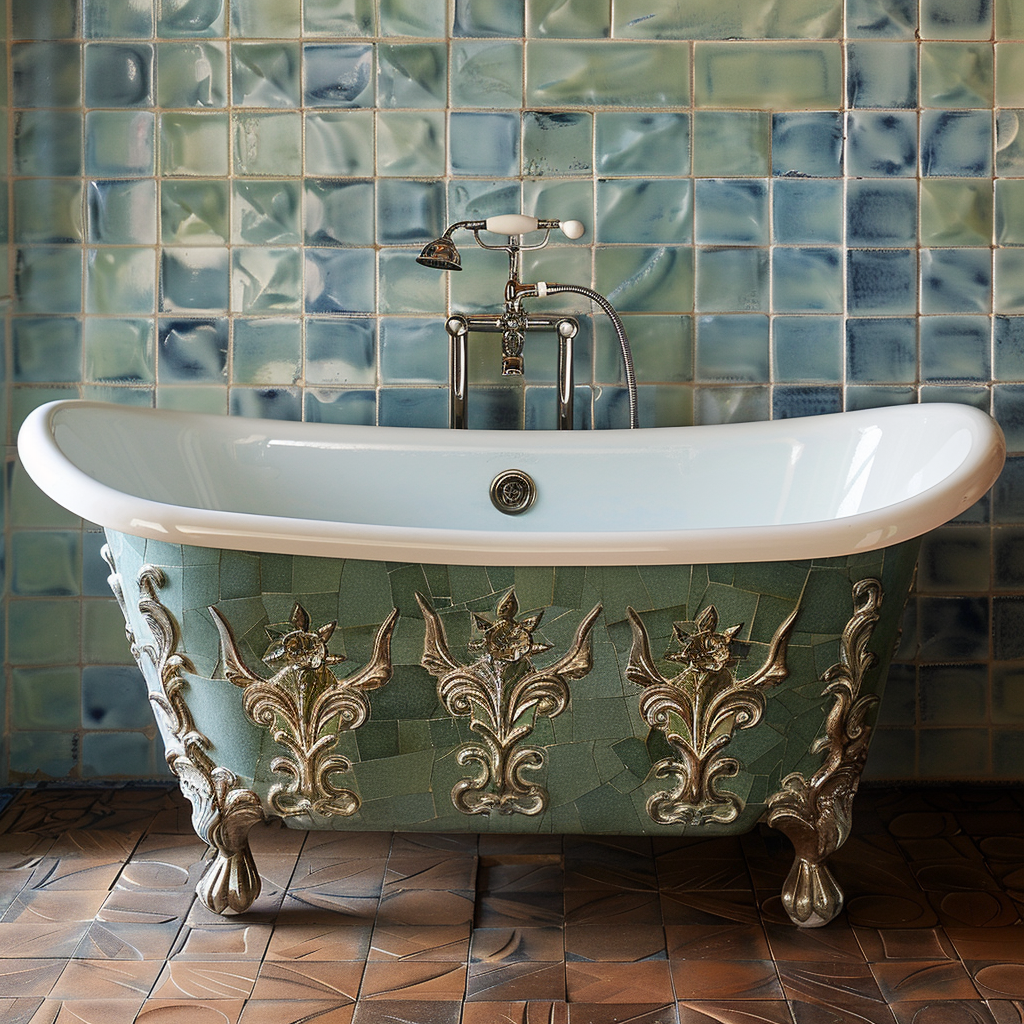
Vintage or antique tile introduces aged beauty and classic charm into bathrooms designed in wabi-sabi style.
Subway tiles, penny rounds, hexagons and other mosaic shapes are timeless options.
Source true vintage tiles from old buildings or buy repro classics.
Mixing eras and types of old tile together makes for an eclectic, imperfect look.
Intentionally mismatched grout lines and irregular spacing adds character.
Some companies sell boxes of old tile remnants or misfit pieces to create one-of-a-kind combinations.
Look for tiles with variation in color and minor chips or cracks that reveal their aged pedigree.
Worn surfaces with an opaque, pitted or streaked finish add depth, especially on subway tiles.
Cloudy clear glass tiles have a frosted, weathered effect.
The variations and signs of wear in vintage tile give new life in wabi-sabi style bathrooms.
The old world appeal and blemishes add soulful imperfections according to this Japanese aesthetic.
Vintage tile brings aged beauty to your bath.
✨Click to Get My 101 FREE Designer Room Ideas
Idea 5: Salvaged or Upcycled Tub
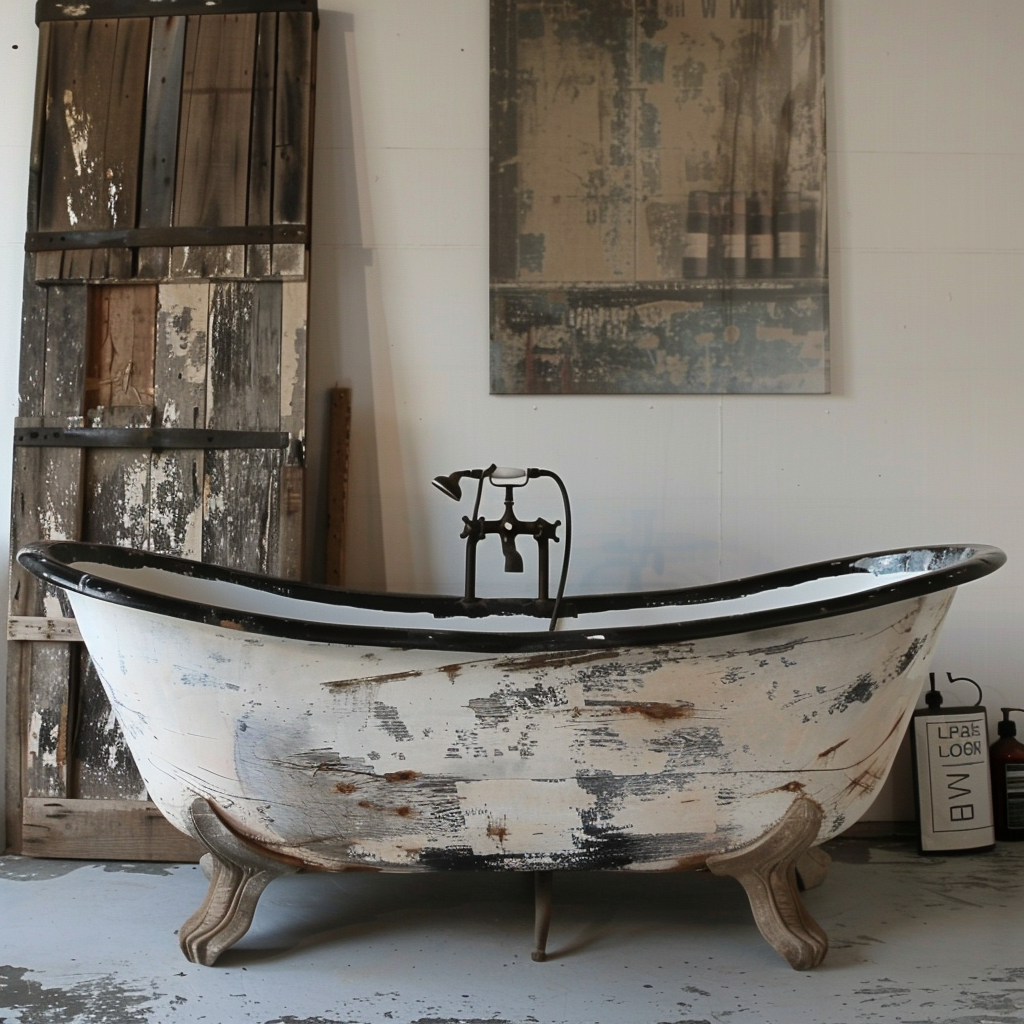
Give an old tub new life by salvaging or repurposing it into your wabi-sabi style bathroom.
Clawfoot tubs from the early 1900s make gorgeous freestanding centerpieces.
Look for ways to convert other vintage tubs like wall-mounted or inset models.
Some companies make custom tub inserts to fit in a pedestal for a freestanding look.
Depending on condition, opt for restoration to functional use or repurpose as a planter, fountain or unique storage piece.
Let the chips, scratches and imperfections show through – or refinish it with rubbed bronze, gloss black or matte white for a renewed yet classic charm.
Distressed metal, well-worn porcelain or old school enamel over steel are all fair game for vintage tubs.
Consider pairing with vintage style plumbing fixtures.
Add a rusted patina or imperfect hand applied finish.
The rebirth of a salvaged tub makes a sustainable and meaningful addition to a wabi-sabi bath.
Idea 6: Rough Wood Shelving

Rustic wood shelving introduces handcrafted warmth to a wabi-sabi style bathroom.
Repurposed old barn beams or unfinished logs offer creative ways to add woodsy bookshelves, wall ledges or bathroom storage.
Leave bark edges untrimmed and wood unpainted for maximum organic texture.
Wood shows its natural beauty when allowed to age unfinished.
Celebrate cracks, splits and imperfections as embellishments, like adding moss or succulents in knotholes.
Floating shelves from reclaimed boards or live edge slabs blend forest spirit with modern minimalism.
Lean shelves against the wall at asymmetrical angles for a casually imperfect look.
Rough wood shelving adds harmonious balance between manmade construction and elements from the natural world.
The rich textures and colors of woodgrain give a wabi-sabi bathroom welcoming, earthy warmth.
Idea 7: Soaking Tub
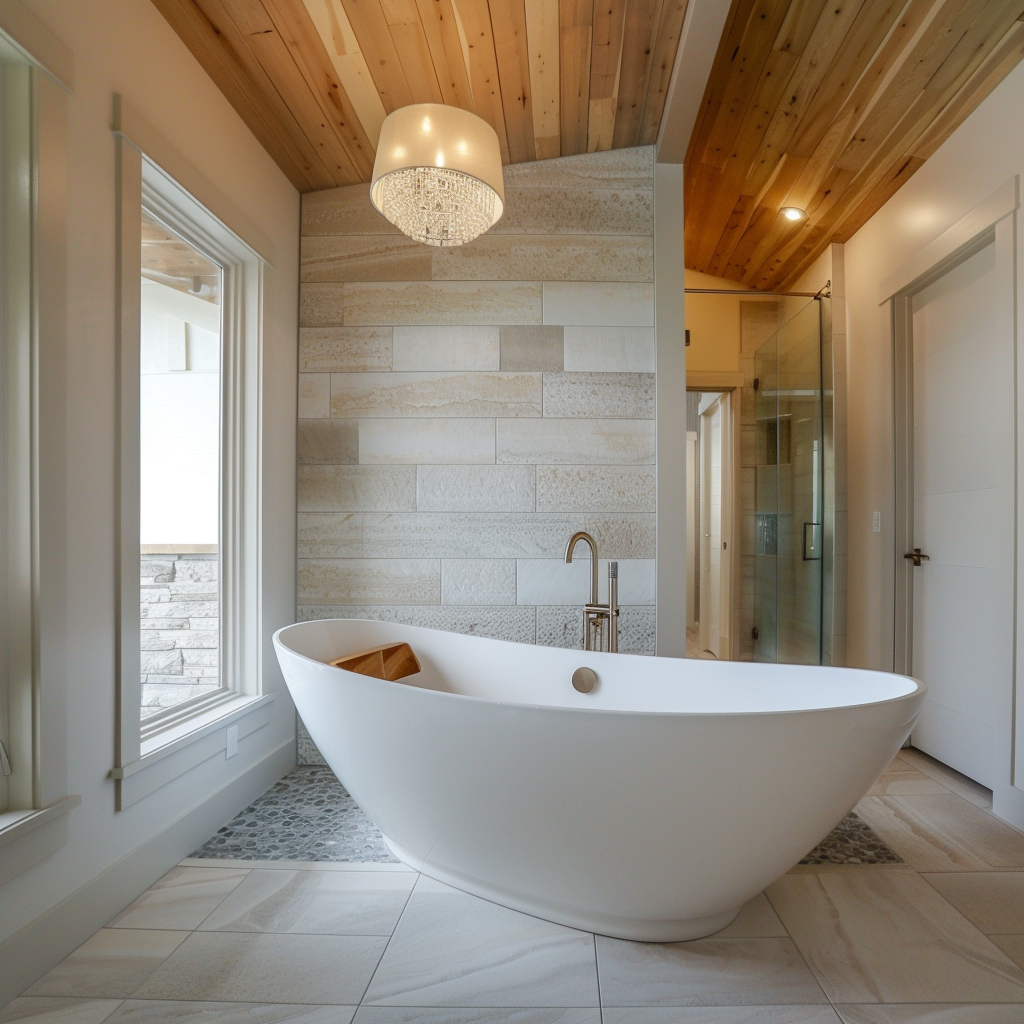
Deep soaking tubs provide a therapeutic experience that calms mind and body – making them a perfect addition for the tranquil wabi-sabi bath.
Choose durable materials like stone, copper, enameled cast iron or solid surface for a long-lasting soak.
Freestanding styles make a sculptural statement, especially oval, egg-shaped or circular.
Built-in variations can be understated – focus on clean lines and minimalist style.
Add a compact wooden bath caddy for candles, flowers and essential oils to set the mood.
Position your tub near windows overlooking greenery to connect with nature as you soak.
Surround the area with natural materials like linen curtains, woven textiles, wood shelving or a pebble floor.
Incorporate wabi-sabi elements like assymetrical sconces, antler hooks or handmade ceramics.
The stillness of a quiet soak cultivates mindfulness and tranquility in the Japanese tradition.
Provide a serene, imperfect setting for this ritual cleansing.
A deep tub offers rest and rejuvenation.
Idea 8: Unlacquered Brass Fixtures

Allow brass bathroom fixtures to age naturally for a lovely imperfection that suits wabi-sabi style.
Unlacquered or living finish brass develops a patina from use, oxidizing into a soft black/brown over time.
Let water stains, fingerprints and minor scratches accumulate – these marks add character.
Select uncoated brass or remove finish from fixtures to appreciate the way brass gains a mellow, weathered look.
Matte, brushed or satin brass provides subtle patina.
Or choose polished brass for bold, brassy tones.
Vintage inspired basin taps, tub fillers and shower fixtures take on a charming, timeworn look as unsealed brass ages.
Solid brass hardware and accessories also gain a lovely, organic patina.
The living finish of raw brass evolves naturally in a wabi-sabi bathroom, showing the markings of daily life.
Aging brass finish aligns with the aesthetic appreciation for aged, weathered beauty.
✨Click to Get My 101 FREE Designer Room Ideas
Idea 9: Classic Subway Tile

The humble subway tile makes a comeback in wabi-sabi style bathrooms.
This classic 3 x 6 inch rectangular ceramic tile first appeared a century ago in busy urban subway stations.
Its smooth surface was easy to clean in high traffic areas.
Adapted to bathrooms and kitchens, the simple shape provides clean lines in a range of neutral hues.
To incorporate subway tile into a wabi-sabi aesthetic, opt for vintage variations with slight chips, cracks and stains that mark the passing decades.
Glossy tiles take on an opaque patina, while matte finish tiles show subtle signs of wear.
Mix shades of white, cream and gray for an imperfect look.
Blend in accent tiles with texture like handmade ceramic or moroccan fish scale tiles.
Stack tiles in an offset or herringbone pattern.
Use varying grout colors and uneven grout lines for character.
Subway’s straightforward shape makes a lovely base to showcase other wabi-sabi elements like weathered woods, antique hardware and organic textiles.
Idea 10: Textured Plaster Walls
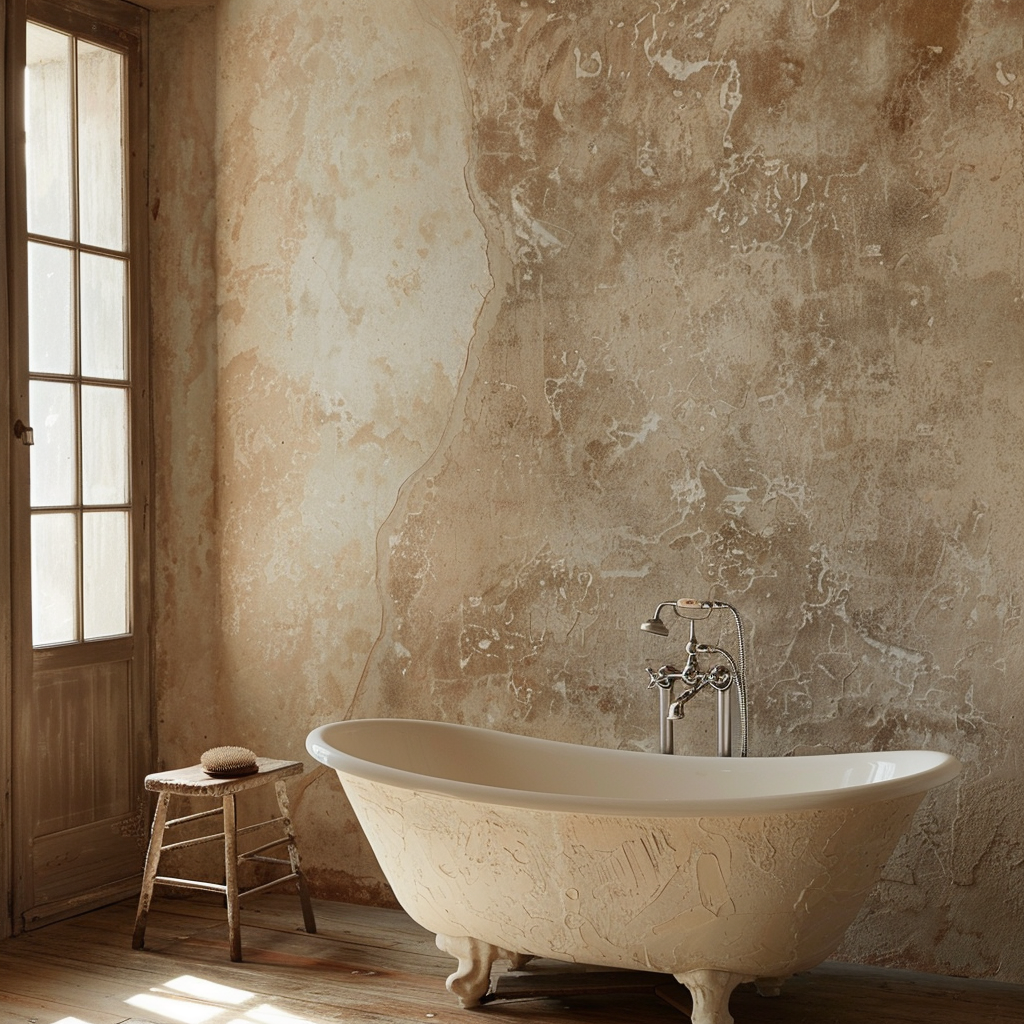
Rough plaster walls provide organic texture aligned with wabi-sabi ideals of imperfection.
Trade slick drywall for an earthy hand-troweled plaster finish.
Or consider lime-based Venetian plaster using techniques like troweling, stippling or fresco to achieve dimensional, mottled walls.
Apply plaster in earthy hues like sand, fog, sage, timber or flax.
Let underlying brick or stone masonry remain exposed for a timeworn look.
Wood boards make an attractive base to accent plaster walls.
Leave visible trowel marks and a hand worked look for slight irregularities.
Use rounded corners and handmade ceramic wall tiles to complement.
The natural variations of plaster create subtle, ununiform finishes.
Plaster’s adaptable texture allows you to shape peaceful surroundings inspired by nature.
Rough, mineral-rich walls evoke an ancient, monastic tranquility in a wabi-sabi bath.
Idea 11: Salvaged Mirror
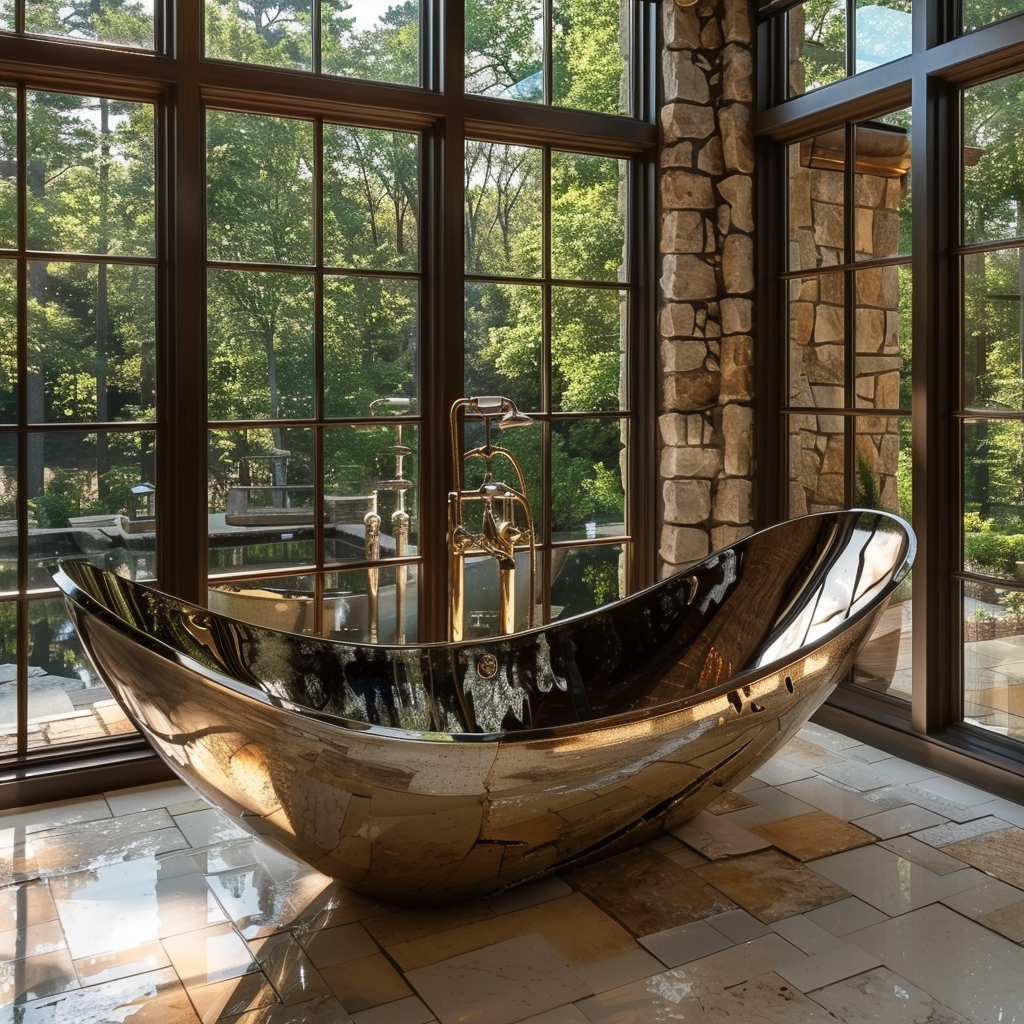
Secondhand mirrors carry a nostalgic beauty that fits beautifully in wabi-sabi style bathrooms.
Seek out antique mirrors with dark spots, clouding and slight distortion indicative of their age.
Ornate frames with chips and worn gilt edging add to the weathered allure.
For a unique repurposing project, cut shards of old mirror to make a collage frame or mosaic accent wall.
Mix pieces of various shapes and sizes to assemble a fractured reflection of light.
Use mirror fragments to make custom vanity skirts or a backsplash over the sink.
Look for mirrors with a scalloped or curved shape and hang them asymmetrically.
Avoid covering the entire wall with mirror – focus on one special accent piece.
The wavering reflection of an antique mirror adds a dreamlike quality to the space.
Flaws and oxidation become adornments.
Vintage mirrors reflect the passage of time with poetic charm.
Idea 12: Handcrafted Ceramics

Display one-of-a-kind ceramic pieces to bring organic, human elements into the wabi-sabi bathroom.
Seek out works by local artists – with minimal glaze to emphasize a raw, earthy look.
Keep shapes simple like bowls, vases or a stoneware soap dish.
Choose freeform sculptures over perfect symmetry – showcasing the maker’s hand.
Subtle variations in firing and glazing add to the handmade character.
Ceramics with cracks, chips or uneven shapes celebrate the artistry in imperfection.
Place ceramic pieces on wood shelving, use as vessels for plants or add to the bathtub’s edge.
Opt for neutral, nature-inspired hues and natural clay textures.
You can even commission custom basins, tiles or soap dishes made locally using natural clay.
Hand thrown, slab built or pinched clay artworks marry earthy materials with human creativity.
The handmade quality brings warmth and uniqueness to the wabi-sabi bath.
✨Click to Get My 101 FREE Designer Room Ideas
Idea 13: Repurposed Furnishings
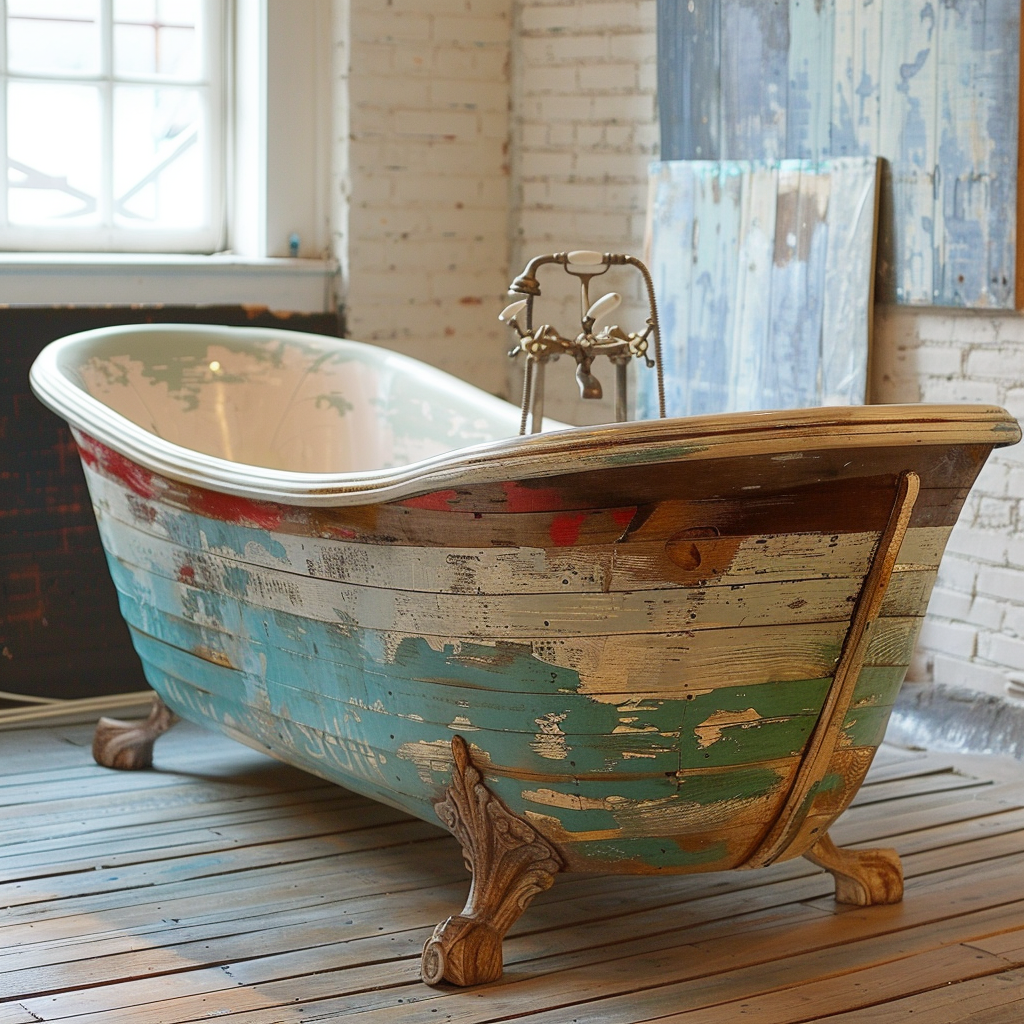
Give worn and weathered furnishings new purpose in the wabi-sabi style bathroom.
From antique benches to vintage ladders, reimagined objects add character.
Turn an old wooden ladder into towel storage leaning against the wall.
Upcycle a farmhouse cabinet as the new sink vanity.
Salvaged shipping crates become rustic open shelving.
Repurposed industrial stools act as quirky side tables.
Look for pieces that reveal their past lives through charming imperfections.
Aged wood that shows nicks, stains, carvings or peeling paint.
Mismatched drawers with painted numbers from old hotel furniture.
Faded upholstery on a cushioned seat.
Add your own special touch by sanding, staining, or adding new upholstery in natural fabrics.function with comfort.
The imperfections and signs of wear give repurposed furnishings nostalgic appeal.
Breathing new life into well-loved antiques and vintage finds rewards the wabi-sabi bath with eclectic, earthy style.
The wabi-sabi philosophy finds beauty in old, worn and imperfect things.
This Japanese aesthetic teaches us to see age, corrosion and irregularity as enhancements rather than flaws.
Wabi-sabi’s organic style creates bathroom spaces that nourish the soul.
By incorporating natural materials like stone, wood and plaster you invite the spirit of nature into your bath.
Salvaged and vintage elements add patina and history.
Handcrafted pieces provide an earthy, human touch.
Curving shapes, asymmetry and visible markings cultivate an intimate, welcoming ambiance.
Follow these ideas to craft your own imperfect, authentic bathroom oasis.
The textures, colors and imperfections of wabi-sabi design connect us to the natural world.
Surround yourself with beauty that endures and evolves over time.
Let your space gather markings that reflect a life well lived.

